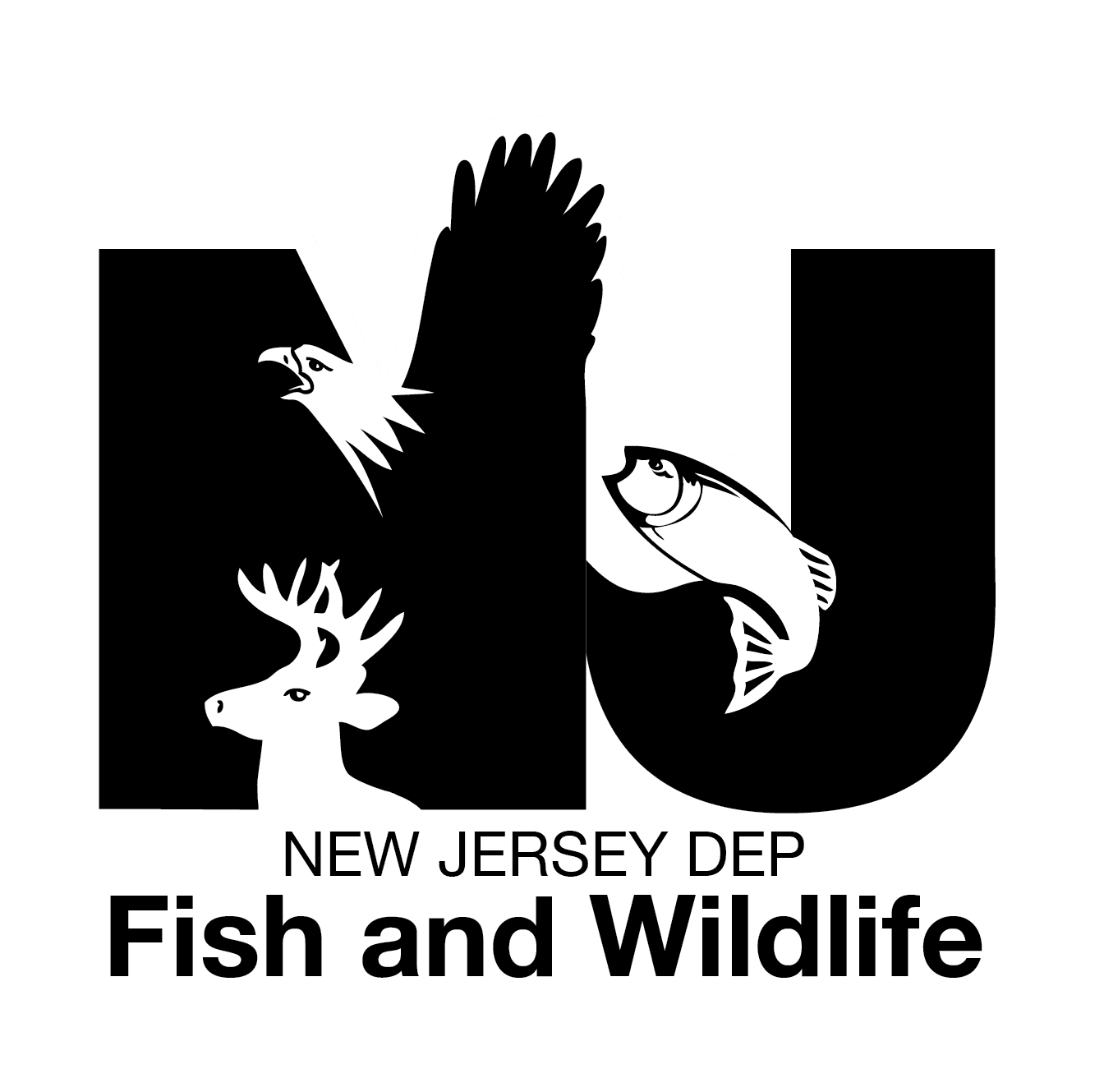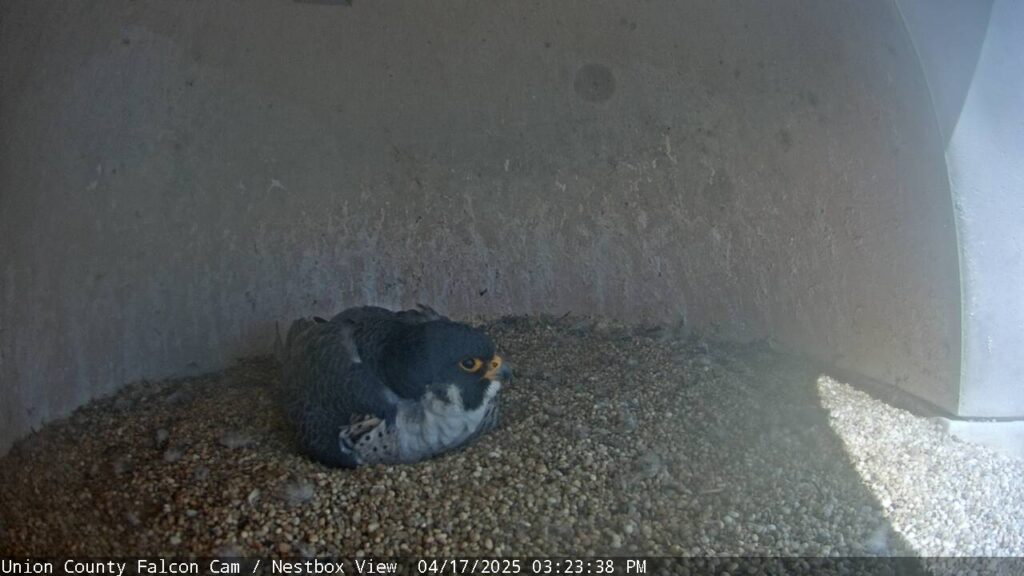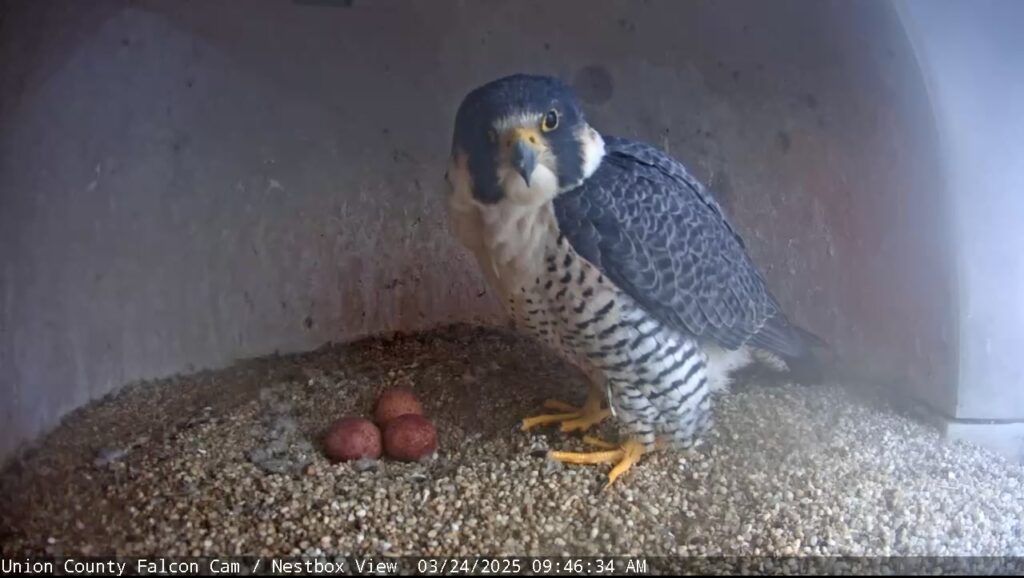Union County Falcon Cam
Elizabeth, New Jersey
Buildings and their owners/managers have played an important role in the successful recovery of Peregrine falcons in New Jersey. After a pair attempted to nest (and were unsuccessful) here in 2005, building managers took action to give these birds a second chance. Since windy conditions made nesting on the roof impossible, Union County staff, as directed by NJDEP Fish & Wildlife zoologist Kathy Clark, installed a Dogloo, also referred to as a “Peregloo” to provide a more suitable nest site. After installing the Peregloo, the nesting pair was productive! Since then the site has been occupied by falcons. In 2016, there was a turnover at the nest and the female was replaced with a young adult. Then in 2019, the current female (who is unbanded), named “Frida” replaced the previous female. The male is named “Mango.” Learn more on Union County’s website
Learn More2025 NestBox News
April 17
Frida and Mango have been keeping their clutch of four eggs warm for the past 28 days. The developing chicks are quickly absorbing the last bits of yolk and building strength to begin breaking through their shells. When they get close to hatching, we often see the adults more restless, fidgeting and paying more attention to their eggs. Once the young break through their egg shell, then we can start to hear them peeping, while taking first breaths of outside air. We have a few more days of incubation, which could put hatching to begin this weekend! 🐣
April 9
We’re now at day 20 of incubation, which began after the third egg was laid. The fourth was laid five days later. Falcons typically incubate for around 30 days, so we should start to see signs of hatching late next week. Once eggs begin to hatch, attention of adults will be directed towards their young with less going to the fourth egg. We shall see if it does hatch.
April 3
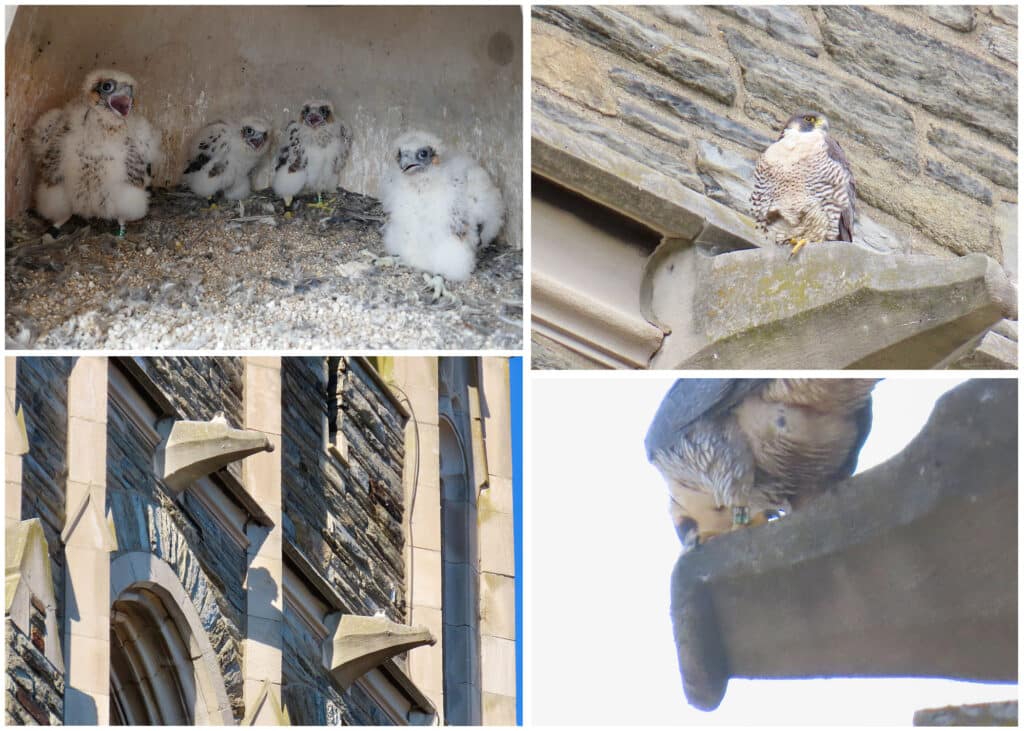
March 26

Who doesn’t love the surprise of a fourth egg? I had a feeling that by saying “it appears that no more eggs will be laid” another would be laid. 😆 Peregrines typically lay 4 and sometimes 5 eggs. The fourth was laid at 2:26:02 PM on March 25. It just took Frida a little more time to develop her last egg (will there be one more?). With that said, incubation is still in full swing.
March 24
It appears that no more eggs will be laid this spring, as the forth egg would have been laid over the weekend. This is not abnormal, as their average clutch size varies from 3-4 (sometimes 5). With incubation underway, this puts hatching to begin towards the tail end of the second full week in April.
Over the next several weeks, we will watch as the pair incubate the eggs where the female does the majority of incubation duties. She will occasionally get breaks to stretch, feed and preen where the male takes over. They will shift/roll eggs to ensure they develop properly several times a day. This prevents the developing embryo from sticking to the shell and ensures even heat distribution.
March 20
Happy Spring! Frida and Mango are now incubating three eggs! The second was laid on March 17 and the third was laid early this morning. Now that they have almost a full clutch of eggs, they will be incubating them more. Their typical incubation period lasts 28 days and the last egg should be laid late tomorrow or early Saturday. This puts hatching close to the beginning of Earth Week. Delaying incubation is a natural adaptation that ensures all eggs hatch around the same time, giving all chicks a better chance of survival. In contrast, ospreys begin incubating immediately after the first egg is laid, resulting in nestlings of varying ages. This strategy addresses prey shortages, where only the oldest nestlings may survive if food is scarce.
March 17
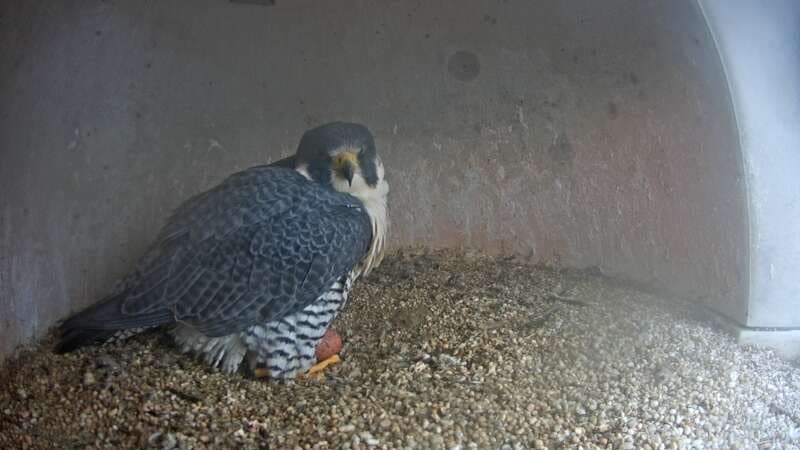
On the morning of March 15 at 6:30am, viewers got their first glance of the first egg. We knew egg laying was close as the pair has been observed copulating, performing eee-chup courtship (bowing) displays on camera. Frida has also been spending more time in the nestbox preparing her scrape, which is a shallow depression in the nestbox where eggs are laid. Peregrines do not build a nest like hawks, eagles and ospreys and instead create a shallow depression in gravel, soil and other debris to nest. This is often the case on ledges of cliffs and in our human dominated landscape, it also includes tall buildings and sometimes flowerpots left unattended on upper floors of apartment building patios. The second egg should be laid sometime over night or tomorrow.
On another note, we decided to wait to remove the worn green carpet for perching. Introducing disturbance to the pair before laying began would not have been good. Instead, we will swap this carpet when we visit the nest for a health check after the young hatch in around 45 days (late April).
Lastly, we opened up chat on two of the live streams on our YouTube channel, so you can watch and talk with other viewers. BW
February 27

Here we go! Those watching closely have seen the pair more and more lately as they strengthen their pair bond by mating and bowing to each other in the nestbox. Some snapshots were posted below. The third camera (showing the other side of the roof) had some technical issues but was brought back online earlier this week. As this website is new, we have to figure out how to display 1-3 of the live streams on this page, but as you know they are all available on Union County’s website (link above).
Some light maintenance will occur sometime in the next two weeks. The green carpet that is worn will be replaced, prey remains will be cleaned up, and lens covers will be cleaned.
Some seasonal notes. Last year the first egg was laid on March 16. In 2022 + 2023 it was March 19, so who wants to bet that an egg will be laid during the third week of March? I’m betting it will be earlier than last year. Time will tell. Either way, it will be great to focus on wildlife and see some new life after what seemed like a really cold, long and dark winter. BW
Interact, post photos and comments
Conserve Wildlife Foundation is proud to partner with Union County to stream the live view of this falcon nest from the roof of the County Courthouse in downtown Elizabeth, New Jersey.
Union County Falcon Cam Education
CWF’s Soaring with STEM program educates children about New Jersey’s unique natural resources and the rare wildlife that shares our environment using the Union County Falcon Cam as the primary technological learning tool. Through interactive and engaging classroom and assembly presentations, our experienced educators bring wildlife into your school. Students are fascinated to discover that these raptors nest and raise young each year right in their own backyards! Teachers receive structured lessons and interactive activities to address the Next Generation Science Standards for grades 3-5. Learning about their wildlife neighbors helps children to connect to their community and teaches children to consider how their everyday actions impact the natural world around them.
A special thanks to Phillips 66 for their sponsorship of the Union County Educational programs utilizing the Union County Falcon Cam.
Sponsors + Partners


